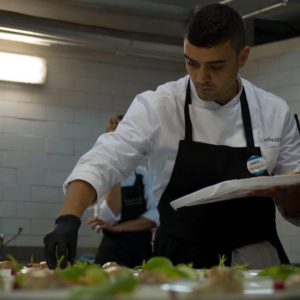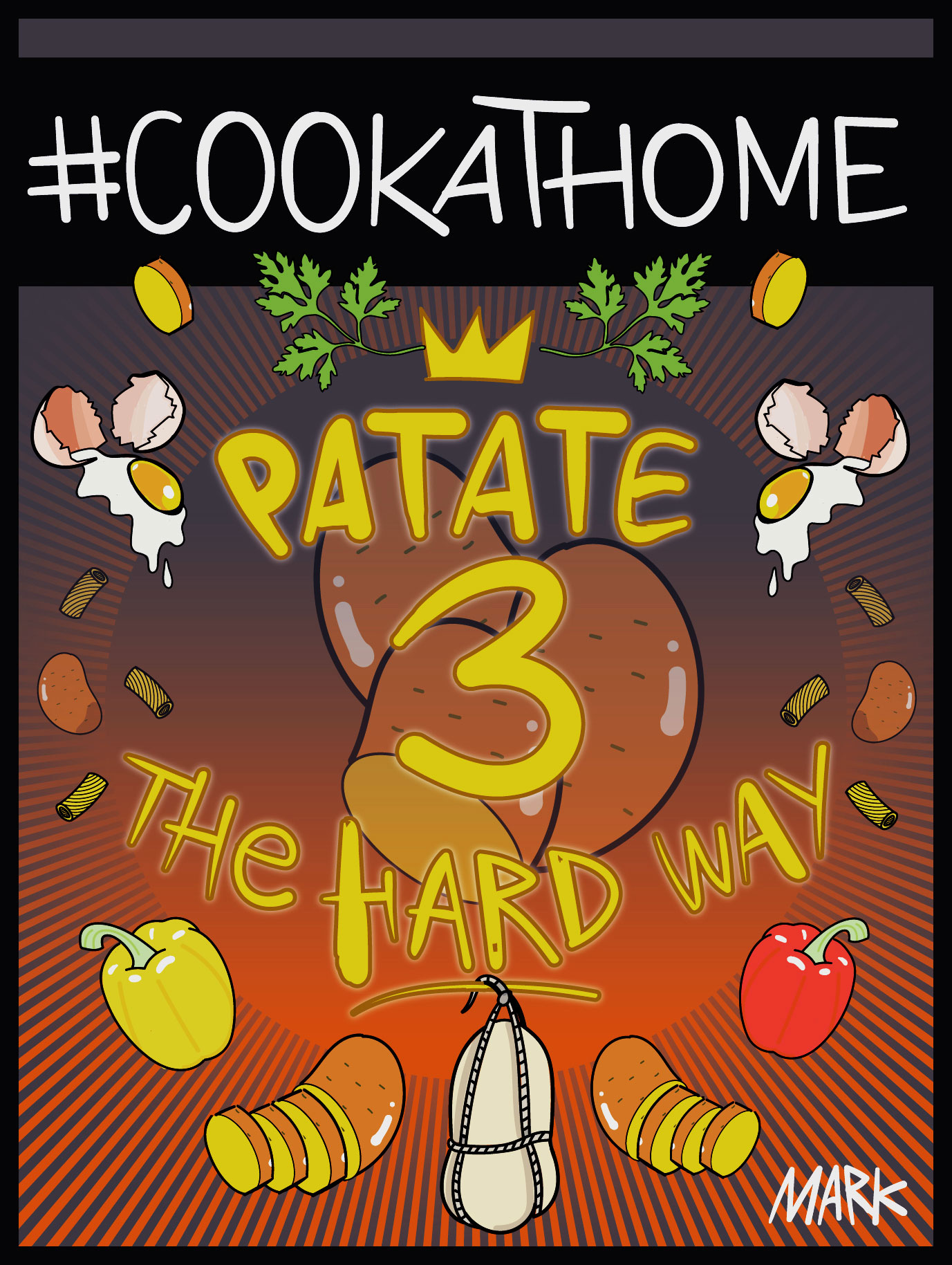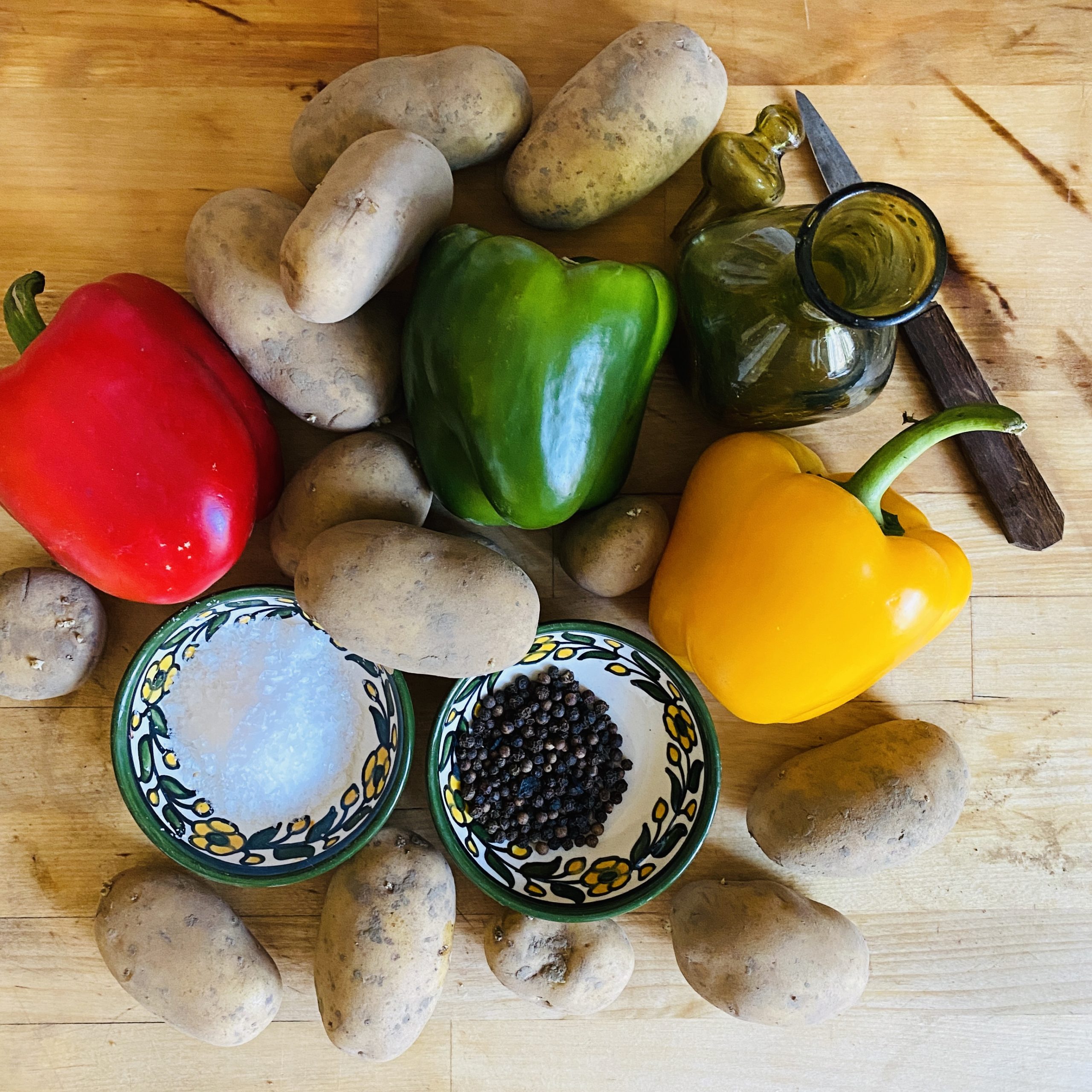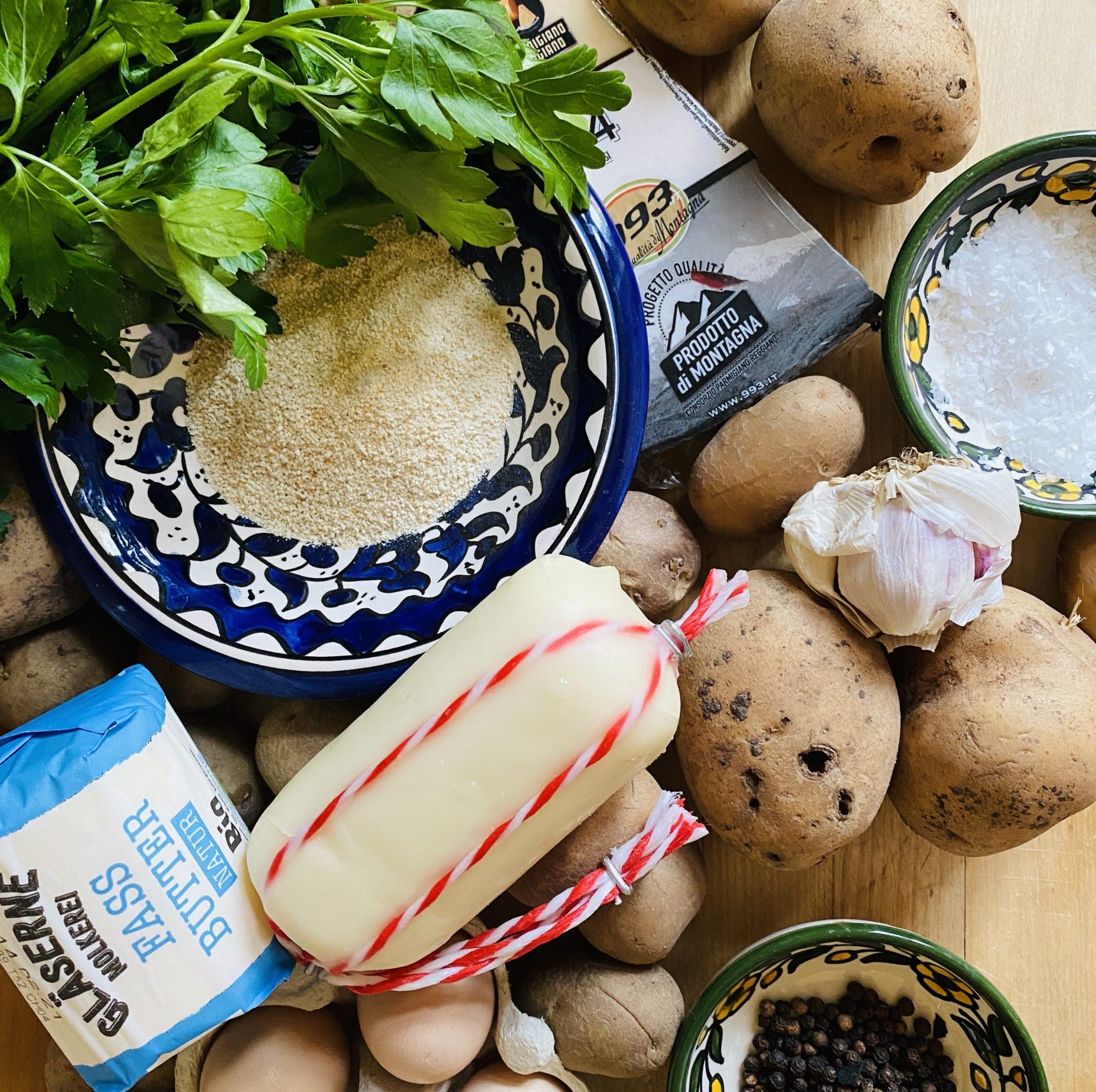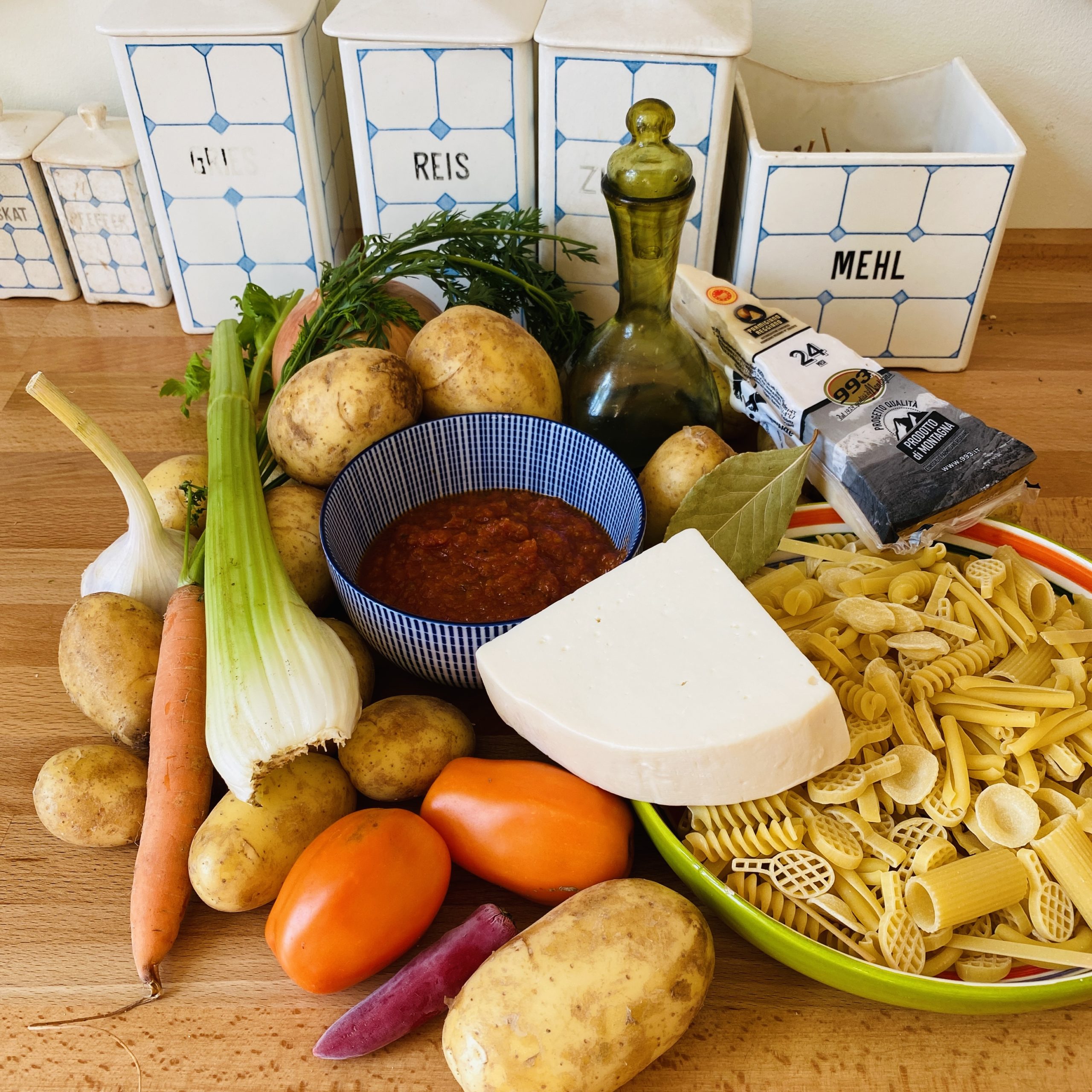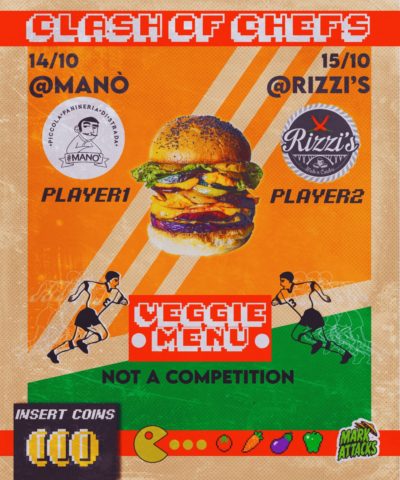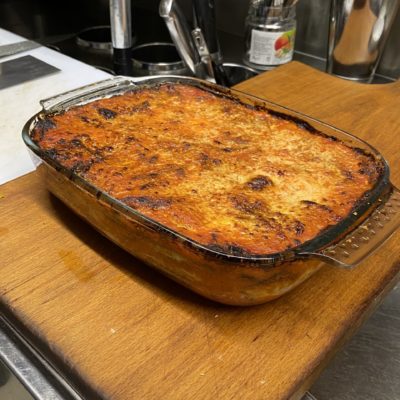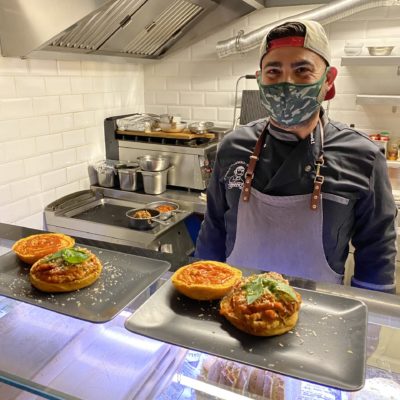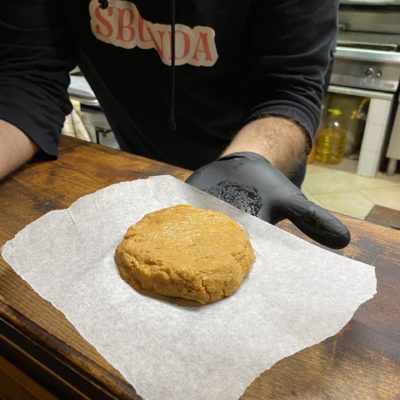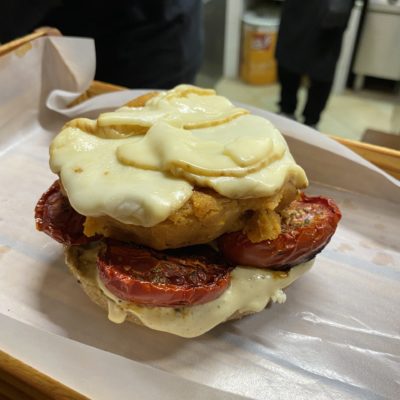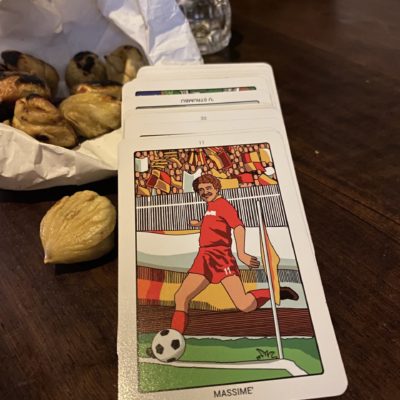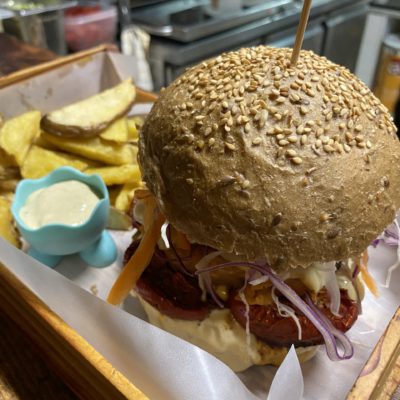Cook-at-home
This is a little project i started during the weeks of shutdown/ #stayathome caused by the Corona Virus.
As it is still unclear if and when i can go back to my beloved Italy i have to compensate that by improving my cooking skills on my favourite italian dishes so i can enjoy them at home.
Fortunately some friends of mine, who are also talented chefs, offered me their help and provide some recipes for me.
I will gladly share those with you on our new Supersonic website and will continue updating it.
Have fun while cooking those dishes by yourself, you can even listen to some of your favourite Supersonic mixes while you´re in the kitchen.
Buon Appetito!
Panza / Supersonic
P.S. extra special thanks to Mr. Mark for those nice graphics!
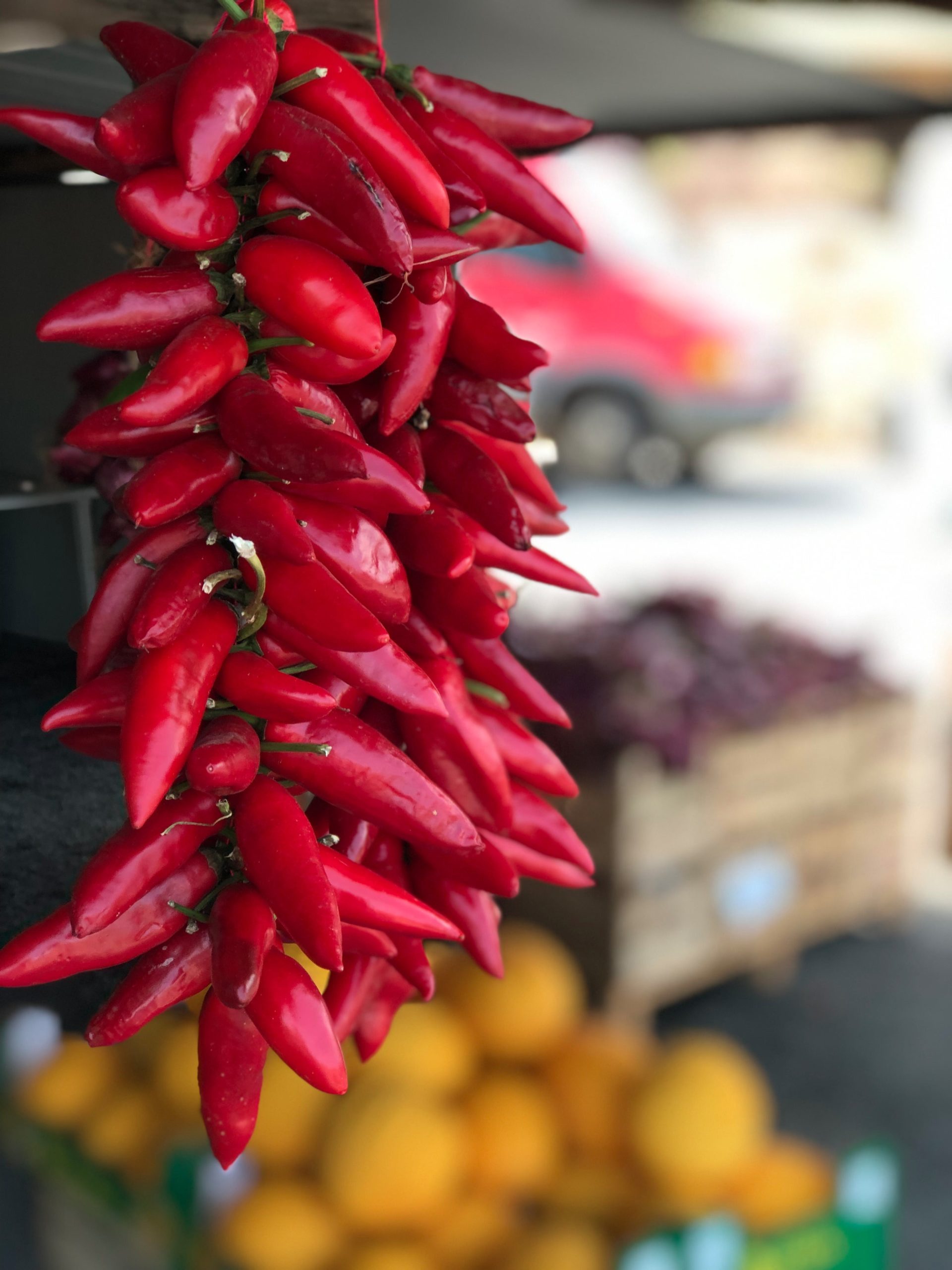
The contributors
Manu

About Manu
Emanuele Plati born in Rome in 1986
Started work in the kitchen in 2003 as dishwasher, then in 2004 and 2005 he worked with his mentor chef Luca Doria where he made his first steps in front of the fire. From 2006 until 2009 he worked in Rome, where he did learn the basic rules of pastry, pasta fresca, meat specialities and fresh seafood during summer season.
In 2010 he started to travel around the world to follow the scents of kitchens and the sound of Dancehall. Berlin,Florence,Rio de Janeiro, New York until his return to Calabria where he works and creates in a chef’s association called “anywaychef”
Every summer season you can find him preparing fresh seafood and playing Reggae and Danchall music on the beach with his sound Catanzion, that also promotes the famous „Dutty Summer” events.
Mario
About Mario
Born in 1988 in Catanzaro he started cooking for himself since he was a child, and continued like that until he did his first step into a professional kitchen in 2009. After that in 2011 Mario graduated as professional chef of Italian cuisine at “ALMA”, the most important cooking school in Italy, lead by Gualtiero Marchesi, close to Parma.
In 2012 he did move around Italy and started to work hard in some Michelin starred restaurants for several years. Right now he moved back to Bologna (that he feel is the greediest Italian city for anybody who loves food) and works as chef in a Grand Hotel Restaurant.
But all the time he never stopped to push Reggae and Dancehall music with his crew “Ematoras Family – The sound of Reggaemilia” and thanks to that he had the chance to meet people from all over the world who became friends in the end.
So if this “challenge” is possible it’s just thanks to the music that we play , that made me, Manu and Panza become friends and that we will be back at in full effect after this hard time.
Buon Appetito everybody!
Ale
About Ale
Ale is probably the person which is most responsible for my addiction to the city of Roma.
In the early 2000s he did often book Supersonic for shows with his sound Love Massive. We had legendary dances together, especially at the famous Intifada Club.
And over the years he and his wife Laura became very close friends and are one of the reasons for me to visit the city on a regular base. Even though i have my list of restaurants i need to check each time, there has to be at least one dinner at their place with home cooked dishes and the best Mozzarella di Bufala from the Frutteria around the corner.
Welcome Ale to #cookathome, i’m looking forward to your recipes!
Marco
About Marco
His knowledge about cooking comes mainly from his family, that raised him with great awareness of food qualities. While travelling the world and with some coincidences he eventually ended up as a chef in an italian restaurant in Vancouver.
He did open Rizzi’s in 2014, at that time he was the only one to serve homemade burgers with almost 100% calabrian ingredients. For the burgers he uses almost forgotten ingredients like the meat of Podolica cow, which is very typical for Calabria, but economically normally not very attractive because of high costs and little output.
Same as the colourful potatoes Viola Calabrese that he also uses for many of his dishes.
In 2019 he did also open a place in Milano called Sbunda to cater exile Calabrians and Milano locals with typical calabrian dishes and products.
Manolo
About Manolo
As a youth Manolo started cooking his favourite pasta dishes like Carbonara and Amatriciana by himself after school,as he wanted to eat them so badly but his older brother and sister couldn’t do them for him.
From there his passion for cooking developed and he took every chance to learn more about cooking and get more experienced.
He did work some time together with Manu (who also provided some recipe for #cookathome already) for a project called „Chef At Home“ and for weddings.
He worked at various places in Italy, but eventually decided to open his own place called #Mano in his home town Catanzaro in March 2020, just 1 week before the nationwide lockdown in Italy in March 2020.
You can only imagine how much energy that takes from somebody who just fulfilled his dream of opening a place of his own. But when i met him he was full of energy and you could feel the passion that he has for his profession.
Gwaan, Manolo!
Mr. Mark
About Mr. Mark
I was introduced to Matteo a.k.a Mr. Mark in spring by Mario, when we started with the Clash of The Chefs /#cookathome project to inspire people like me to cook their favourite dishes at home.
Matteo provided the graphics for some of the recipes and also does most of the artwork for Rizzi’s and #Mano nowadays. After he finished studying Science of Public Administraion in Catanzaro he also did an art school diploma to follow his passion as a graphic designer. Check out his works on Instagram, you can also contact him there for your ideas.
During our conversations i realised that in his family are some passionate chefs. I will try to convince them to provide me with some of their recipes. Rumours have it that there is a recipe for a vegan version of Morzello, a typical dish in Catanzaro that normally is made from intestines placed in Pitta bread.
Patate 3 The Hard Way
After receiving some great feedback for the Melanzane 3 The Hard Way it was time to think about another veggie that deserves a special presentation. There is a stereotype that potatoes are considered typical german stomach fillers, but the italian kitchen provides some really nice ways of preparing this little allrounder as well.
And as much as i love pasta i have to admit that during this challenge i kinda rediscovered potatoes and they are on my diet more often than before.
Thanks again to my italian friends and their families to give me some input and make me continue with this blog.
Pipi e Patati
On one of my first trips to Calabria i was introduced to this speciality at the famous Donna Lina. On top of the beautiful Caminia beach (probably my favourite, especially early in the morning when it is still empty) i was handed a piece of bread filled with delicious potatoes and sweet pepper. Such a simple dish, yet it took me some years before finally trying to cook it at home.
The recipe was provided by the father of my good friend Mr.Mark, who is doing most of the Supersonic graphics nowadays.
Here is the recipe of Giuseppe a.k.a Beppe:
1 kg of potatoes
2 or 3 sweet peppers, i went for red, yellow and green 🙂
oil
salt
Wash the potatoes, peel them, cut them into wedges (not too thin) and dry them with kitchen paper.
Wash the peppers, cut them in half, remove the outer stalk and the seeds and white parts inside. Cut them into 2 centimeters wide slices and dry them. If you want to prepare them Catanzaro style, pour plenty of oil into a pan for frying.
The original recipe uses extra virgin olive oil but you can also use a good seed oil.
When the oil is hot, fry the peppers for 15 minutes until they are soft and colorful.
Drain and remove excess oil.
Use the same oil to fry the potatoes, also for about 15 minutes.
Drain and dry them on kitchen paper. empty the pan and mix the potatoes and peppers.
Stir the mix on low fire to mix the flavors and add some salt. Turn them from time to time with a wooden spatula very carefully to prevent the potatoes from breaking. After about 20 minutes, drain well and add some more salt. Eat them immediately, but they are also delicious when served lukewarm or even cold.
In other areas of Calabria potatoes and peppers are fried at the same time. But i felt preparing them seperately i had more control to check when they were ready. And using some good olive oil might be more expensive, but in my opinion it was really important for the taste.


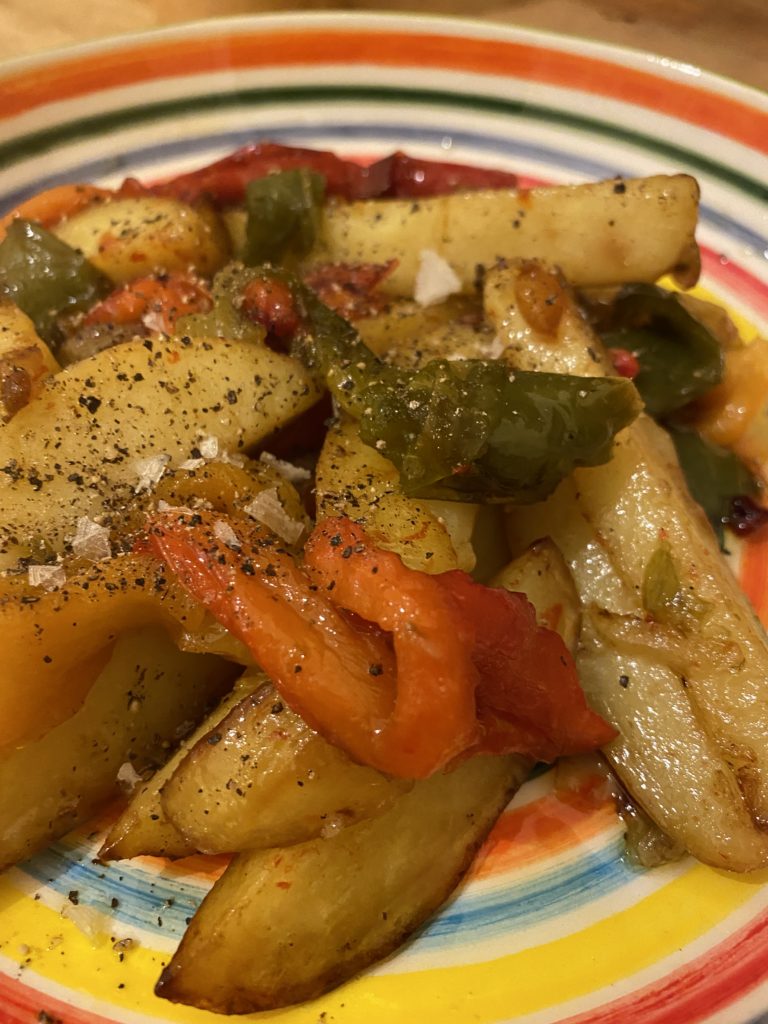
Scuma di Patate
The “gattò” (in Catanzaro it is called “Scuma di Patate” is a potato flan that is also cooked in other regions of southern Italy.
Its origin probably dates back to the teachings of french chefs called to cook for the noble families of the South. This recipe is a vegetarian version by Giuseppe, the father of Mr.Mark.
Ingredients for 4 people:
1kg of potatoes.
200 gr of soft cheese (in Calabria provola is used but you can also use dry mozzarella, gruyere and other cheeses that are easier to find)
60 gr of grated Parmigiano
3 eggs
breadcrumbs
salt
pepper
parsley and
garlic.
Wash the potatoes and boil them for about 30 minutes. Check with a fork if they are soft enough, then peel them and make a soft dough. Mix them with half of the parmigiano and season with butter, salt, pepper, garlic and chopped parsley at your gusto.
While the dough is warm, mix it with a raw egg. In the meantime boil the other 2 eggs, peel them and cut them into slices or wedges.
Take a non-stick casserole measuring about 25cm x 15cm. Grease it with butter on the bottom and sides. Cover the inside with breadcrumbs and pour in half of the potatoe mix. Add a layer of diced provolone and hard-boiled eggs then cover it with the rest of the potatoe mix.
Cover everything with the breadcrumbs mixed with parmigiano. Add a few flakes of butter and bake at 200 degrees for 20-25 minutes until the surface is brown. Wait about half an hour before serving.
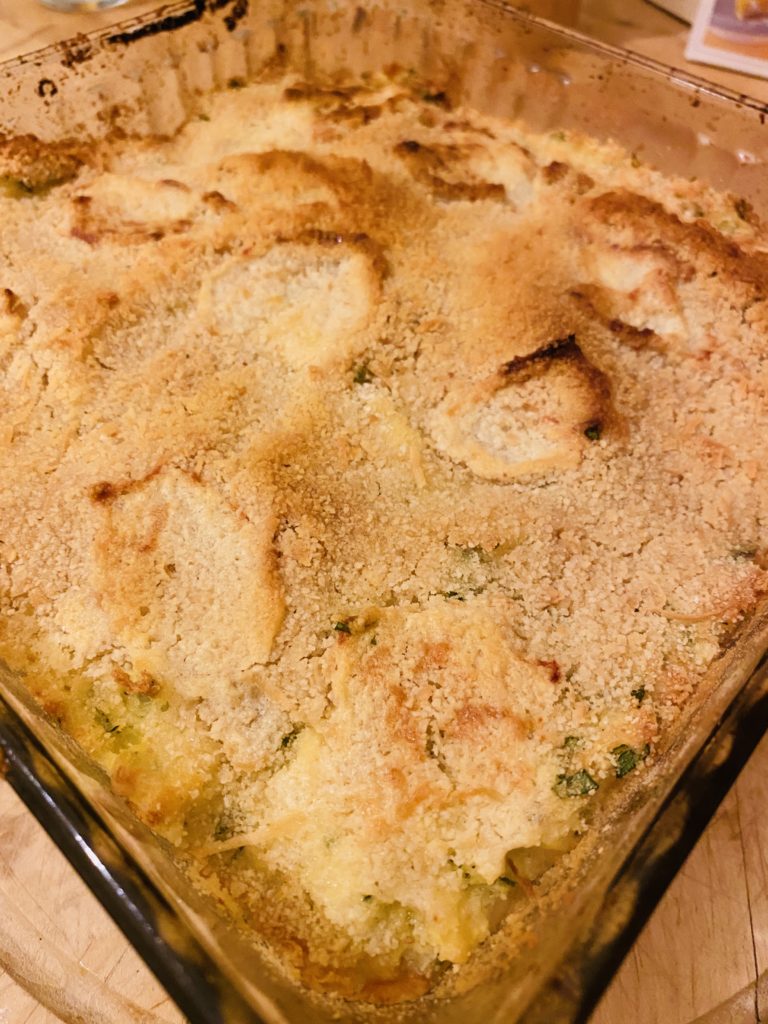

Pasta e Patate
This recipe was once again provided by Mario. I will hand over the mic to him to explain you how to prepare this delicious meal.
Introduction Round:
You’ll never find two same “pasta e patate” recipes. Everybody makes it different in every city or village in southern Italy.
The one that i love to prepare i did learn when i was about 15 or 16 yo from an old man from Naples way before i became a chef.
Many years later i prepared that one for a napolitan chef who really liked it!
Now i modified that one in a vegetarian way, but it should work sameway.
The only problem you could have with the recipe is that all the potatoes are different so you can have different time of cooking or different results with the various kinds. I always use “patate della Sila o patate a pasta gialla” but after a couple of tries you’ll surely understand how to do it with the ones you have.
In Italy we call also mountains potatoes probably there’s something similar over there.
* i did use some young, yellow skin potatoes, which should cook floury
Ingredients for 4 people:
– pasta mista 400 gr
– potatoes 1,5 kg
– tomato sauce (you’ll need just the half of a cup but it’s important that it is already cooked the same way as for a pasta dish with tomatoes)
– 1 piece of celery, 1 carrot, 1 onion and 1 tomato (this is optional but in a vegetarian version without pork fat this fond helps give some extra flavor)
– parmigiano 100 gr
– smoked provola 150/180 gr
– garlic 1 clove
– fresh red peperoncino
– laurel 1/2 leave
– white wine (less than the half of a cup)
– black pepper
* my local cheese dealer didnt have smoked provola, but some nice aged provola with a strong taste, which Mario approved as good to use.
I was really lucky to get 2 nice orange Carmen tomatoes freshly picked from my parents garden.
As i couldnt get pasta mista in any shop in my area so i made my own custom mix of Casareccia, Rigatoni, Racchette, Orecchiette, Fussili and break up Fettuccelle and Mafaldine
Second Round a.k.a Pork Meat Soundsystem Elimination
Take a pot of water as if you want to cook some pasta and prepare a vegetable stock with celery, carrots ,onion, tomato and the laurel. Let it slowly boil at least for one hour. If you have a couple of juniper berries put those in the stock too. Use a bit of salt, but not as much as if you have to cook pasta.
While the stock is boiling, clean and cut your potatoes in 2 cm dices and put into a bowl with fresh water for about 30 min. Change the water a couple of times. This step is important to let potatoes lose some starch.
After that, drain and dry the potatoes as well as you can. Then take another pot, preferably a large one that can hold easily all the ingredients in the half of the pot.
Put the pot on the stove and put some EVO oil in it (you can be quite gentle, because the potatoes will absorb a lot anyway, not too much though, you don’t need to fry them)
When the oil is hot add the garlic and the potatoes and keep it turning for about 10 minutes. Always keeping attention to don’t let it stick to the bottom.
After 10 min remove the garlic and add the red pepper and the tomato sauce (the quantity of tomato sauce is up to you, usually I use about half of a cup for 3 or 4 people)
Let it cook for about 5 minutes, just that potatoes absorb the sauce and when it starts to looks dry put in some white wine. Let the wine evaporate and then cover all the potatoes with the stock that is boiling (obv. already strained) and adjust with salt.
At this point you can decide to let it boil for 2 or 3 minute more and stop before your friends come and make the next step when you have to finish cooking to eat.
Or if you want go on directly let it boil for 6 or 7 more minutes before going into the next round.
Third Round a.k.a Custom Round
At this point you should have a pot with the stock and a pot with the potatoes both boiling (*like a DJ-Deck 😉 so you can add the pasta mista directly in the potatoes pot and if the water inside the pot is not enough to cover all the stuff, you’ll have to add more stock (about 2 inches higher than the pasta level). Now add a bit more of salt.
Usually when u cook pasta this way it take some minutes more than written on the package. So if it says 9 min it will probably take 13 or 14 min to cook.
While cooking always keep it turning and with a spoon smash some of the potatoe dices on the border of the pot to have a creamy effect in the end.
Meanwhile you can cut the provola in small dices or you can shave it with the large holes shaver, always keeoing an eye on the pasta to make sure it does not stick to the bottom. If it dries up add some more stock to keep it covered with water.
In the last 4 or 5 minutes you can let it drain adding water just a little by a little reaching the consistency you want and tasting the pasta for the cooking point.
When u feel that the pasta is on point and that everything reached the right texture, adjust with salt, some black pepper, parmigiano and just one moment before serving add the provola.
Tune Fi Tune: 1 plate each
No trophy needed, all participants are lucky winners.
The gold will be on your hips the day after 🙂
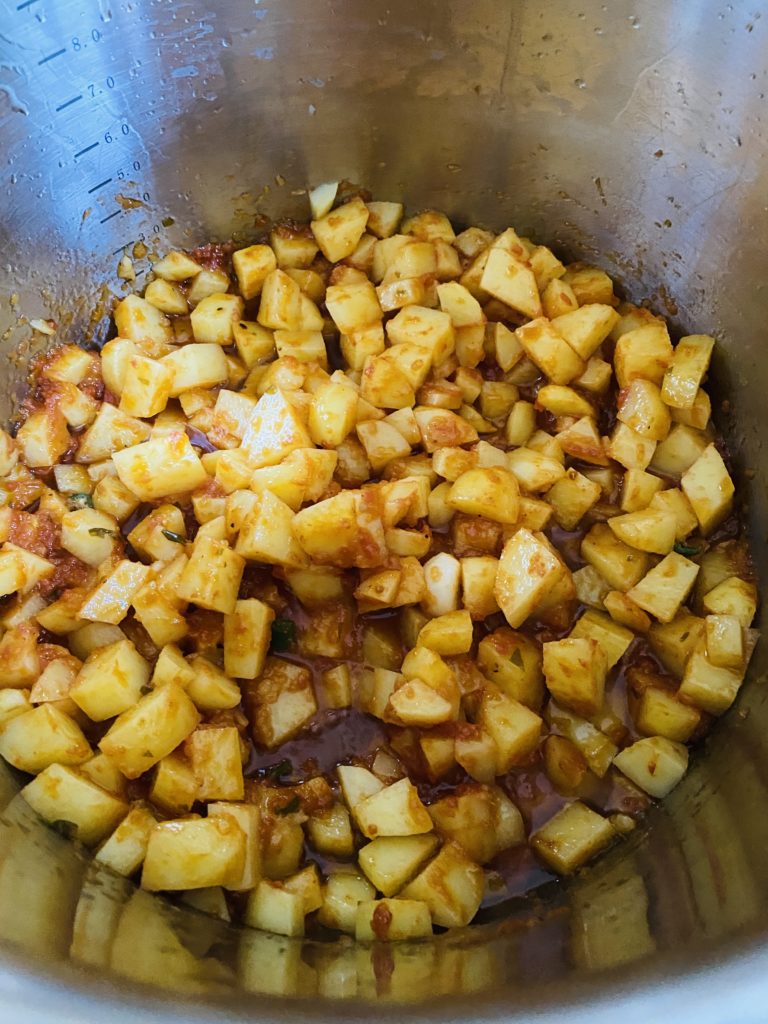
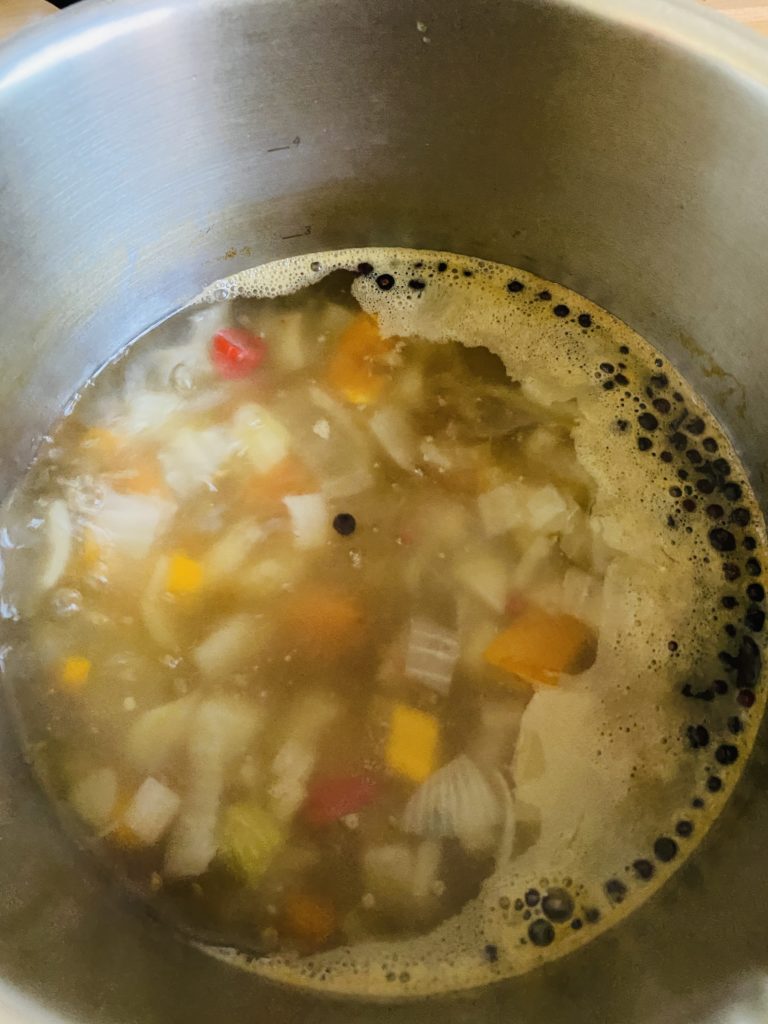
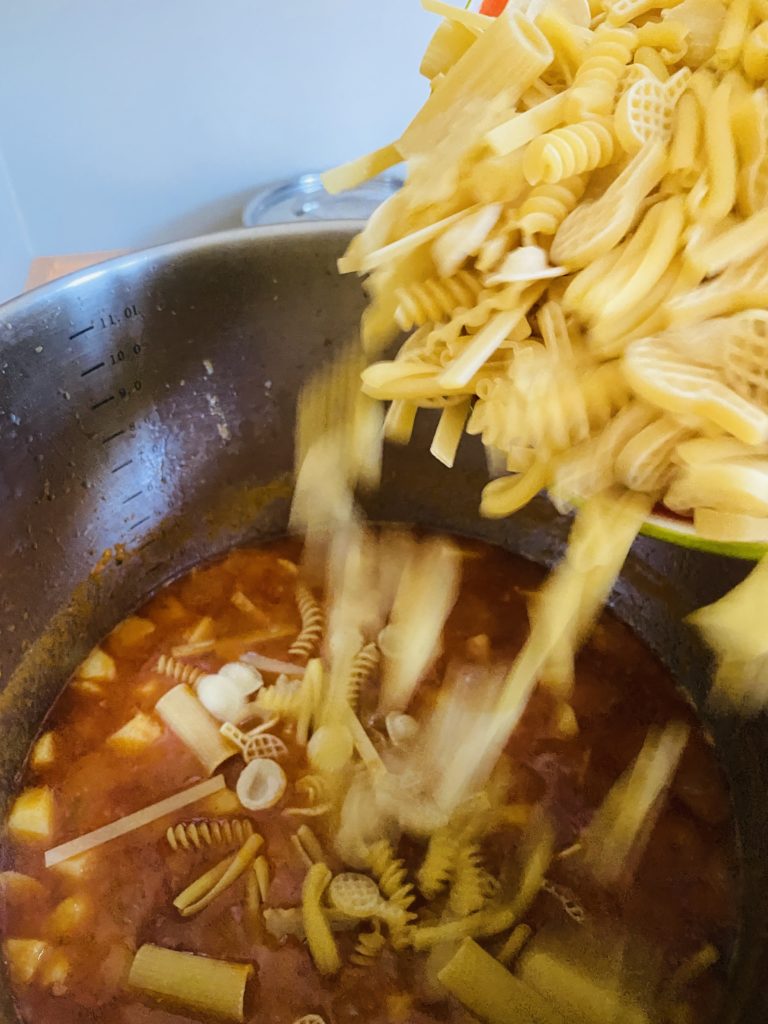


Clash Of The Chefs – Catanzaro Edition
This time i want to introduce you to Rizzi’s and #Mano, 2 wonderful places to eat in the historical center of Catanzaro, only a stone throw away from each other.
While being once again in Calabria i asked the owners Marco and Manolo to create a vegetarian dish in their style and give me the recipe, so me and you can prepare it by ourselves and #cookathome.
Both, Manolo and Marco, grew up in the same neighbourhood in Catanzaro, Mater Domini, where Marco used to play Basketball with Manolo’s older brother. While none of them had a professional education as chef, they both managed to turn their passion into a business and proudly serve the hungry locals and visitors some typical calabrian dishes with an international twist, using mostly regional products.
Our partner in crime for the competition was Mr. Mark, who also provided already some graphics for the #cookathome project before.
The first evening we did spend at #Mano where Manolo served us the super delicious „Grandmano Burger“. He chose the name as a reference to his grandmother as the taste of this dish reminds him alot of her.
The main ingredient for the burger is basically a Zucchini Alla Parmigiana, a nice variation of the more common Melanzane Alla Parmigiana (check out the Melanzane 3 The Hard Way for this recipe). Other ingredients are homemade ketchup, basil oil and a Catanzaro Bun, a bread made on his preferences by a local bakery which uses garlic, olive oil and peperoncino for the dough.
The taste was really spectacular, full of flavours but all in harmony. And the Parmigiana was working surprisingly good as a veggie burger patty.After having a few shots of Jefferson Amaro we couldn’t resist to order another portion.
Well done, Manolo!
Stakes were high for the second evening at Rizzi’s, but Marco stood his ground on the competition. When we reached the preparations where in full bloom and Marco started to prepare his „Ceciburger“. Ceci is italian for chickpeas , and those are a huge favourite of mine, especially for making my own humus and masabaha since a few years (maybe one of those days i will post my recipe for you ;-).
The main ingredients for the meal were the ceci patty, a layer of roasted tomatoes, coleslaw, slices of Provola affumicata, all placed in a bun that was also made especially for Rizzi’s from a local bakery. On the side he served fries made from Patate di Sila (Agria) and homemade mushroom mayonnaise.
After taking the first bite it was clear that there will only be one winner in this competition, and that was me, and the feeling that i will get closer to the italian meaning of my name, Panza.
My favourite component in this burger were the roasted tomatoes, those should also work great as a dish on their own. The texture of the ceci patty was very heavy and filling up the stomach fast.
Unfortunately, despite having some of Marco’s fantastic homemade amari (rucola, finocchio, agrumi..!!) , it was impossible to eat another one as our bellies were almost bursting.
So in the end Manolo and Marco both deserve the crown for the Clash Of The Chefs Catanzaro Edition!
I had 2 wonderful evenings at their places and great conversations with some new friends, i learned more about Calabria, was introduced to the card game „Il Mercante In Fiera Catanzarese“ (and managed to buy one the next day) and on top of it all i did had some super delicious food.
Thank you Manolo, Marco and Mr. Mark for making this possible and please, if you read this and are in Calabria or plan to go there, make sure to check them out!
Manò – Piccola Panineria di Strada
Via Monte, 8, 88100 Catanzaro CZ, Italien
Via Santa Maria di Mezzogiorno, 88100 Catanzaro
Grandmano Recipe
Grandmano Burger
parmigiana
1 yellow sweet pepper
1 red onion (Di Tropea if possible)
1 carrot
6-7 small zucchini
20 fiori di zucca ( or thin pumpkin slices)
flour
tomato passata (around 700 ml)
Provola (non smoked) in thin slices
Pecorino di Crotone (or any other aged Pecorino you can get hold of)
plant oil
ketchup
– rest of the tomato sauce
– brown sugar
– white sugar
– white vinegar
– dark vinegar
– 1 mango
– 1 habanero chilli
basil oil
– 400gr basil
– 250 ml olive oil
– 1/2 lemon
Cut up the sweet pepper, carrot and onion and cook them on low heat with olive oil, pepper and salt until golden.
Then add the tomato passata and let it simmer on low heat for 45 minutes, mix it and cook for another 2 hours on low heat.
Manolo did use Fiori Di Zucca for his Parmigiana, but as those are as rare as Dodo feathers in Berlin i asked him for a substitute and he did recommend thin pumpkin slices instead.
Cover the Fiori Di Zucca or the pumpkin slices in flour and fry them in the oil. In the meantime cut up the zucchini in slices and fry them too.
Now we fill the casserole with layers in this order:
1. tomato sauce
2. fried zucchini
3. provola
4. fiori di zucca (or pumpkin slices)
5. pecorino
Repeat until you have 4 layers, cover it up with tomato sauce again and put a generous amount of pecorino on top. Put it in the oven for about 25 minutes at 230 degress Celcius.
For the ketchup use the rest of the tomato sauce, mix it with 2 tsp brown sugar, 1 tsp white sugar and 2 tsp of white vinegar. Cook the mix at 90 degrees Celsius for about 20 minutes.
Use another small pot and cook the sliced mango, habanero with a glass of water. Add 2 tsp dark vinegar and 3 tsp white sugar and cook until soft.
Then mix the 2 sauces.
For the basil oil simply mix 400gr basil with 250 ml extra vergine oilive oil with the juice of 1/2 lemon.
If you decide to bake your own bun you can use some garlic, olive oil and peperoncino for the dough, same way as Manolo gets it done for his burger.
Now you can build your Grandmano burger, starting with the bottom side of the bun, add a piece of the parmigiana, put some basil oil on top, decorate with some basil leaves and then cover it with the top side of the bun that has some ketchup spread on.
Buon appetito!
Ceciburger Recipe
Rizzi’s Ceciburger
Ingredients:
ceci patty
2kg chick peas
5 tomatoes
2 celery sticks
4 carrots
5 red onions
2 garlic cloves
6 potatoes
breadcrumbs
roasted tomatoes
– Roma tomatoes
– salt
– pepper
– oregano
– olive oil
– brown sugar
coleslaw
– carrots
– white cabbage
– red cabbage
porcini mayo
– eggyolk
– olive oil
– dried funghi porcini
– lemon
– Provola Affumicata in slices
– bun of your choice
Put the dried chick peas in water over night and change the water a few times. Place them in a large pot with water and start to cook them for about 2 hours. After a while you can add the tomatoes, carrots, celery, potatoes, onions and garlic and let them cook until most of the water is gone. Mix everything and add some breadcrumbs if there is still too much water in it. Continue until the mix is strong enough so you can form some patties of around 130gr. each. You can easliy produce some more in advance and store them in the fridge and use them whenever you want. Heat them up either in an oven or in a pan, using some baking paper.
Cut the Roma tomatoes in half and place them on a tray with baking paper and put some salt, pepper, oregano, olive oil and brown sugar on top. Bake them in the oven at low temperature for about 3 hours.
Grate carrots, red and white cabbage for the coleslaw.
For the mayonnaise put some dreid Funghi Porcini in water and let them soak. Dry them carefully after and put them into olive oil, mix it and then filter the mix to get the bigger mushroom pieces out. Beat up the egg yolk and mix in the oil in small amounts until you get the desired maynonnaise texture. Add some lemon juice at the end.
Now you can start to prepare the burger, starting with a layer of Provola Affumicata on the bottom side of the bun. Put it in a grill or oven until the cheese melts, then place a layer of the roasted tomatoes with the ceci patty on top, and another layer of Provola. Add some of the coleslaw and cover the burger with the top side of the bun.
Voila!
Serve fried potatoes with the mayonnaise on the side. As Marco, you can check for some special sorts of potatoes from your region. At Rizzi’s they use Viola Calabrese alot, they have a colourful skin but are white on the inside and are a bit more expensive as they produce only a few kilos per acre.
Cacio E Pepe
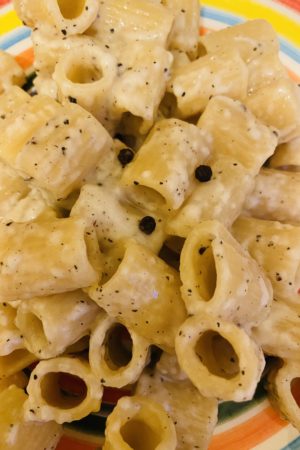
This is a very emotional dish for me as it resembles my love for Roma in a culinary way. No trip to Roma is possible without trying at least 1 or 2 different Cacio E Pepe.
While the ingredients are super simple, it is very easy to spoil it and have just a cheesy, greasy pasta as result.
There are a few places that i can recommend for this one, but my personal favourite so far is the one at Flavio al Velavevodotto. It is an excellent place to eat also for many other dishes, like Carciofo Giudia.And it is a very interesting location as it is build right beside the Monte Testaccio, which consists of broken amphores that are more than 1000 years old.
Cacio E Pepe by Ale
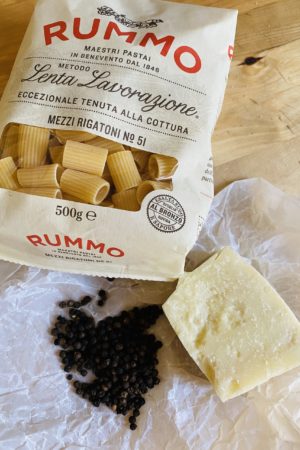
If i remember correctly Ale took this recipe from a Youtube turtorial by one of the chefs at Flavio.I tried to cook it many times at home before, but i only get decent results since i follow his instructions.
As with most simple dishes the main part is to get the best ingredients.And you only need 3 for this recipe:
– Pasta (while the most common pasta for this one is Tonarelli, i comply with Ale’s preference of Mezzi Rigatoni, especially the ones by Rummo)
– Pecorino Romano (nowadays it should be not too hard to find it in well sorted markets)
– Black Pepper (my personal favourite is Periyar Pepper, but of course it also works with any other good black pepper)
For the cacio i take a large bowl where i put the ground Pecorino Romano and a generous amount of ground pepper. I slowly stir in small amounts of water with a spoon, just enough to get the mixture wet but still solid. As a guideline i use the rule to have 1 eggsize portion for around 100g of pasta.
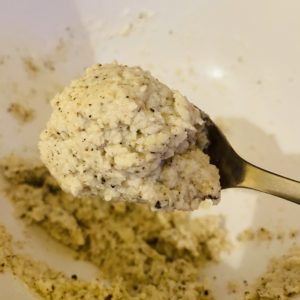
In the meantime cook the Rigatoni al dente. Once they are finished put them in the bowl and start stir. The temperatur of the still hot pasta will help to get a nice creamy texture. It might take a few times to find out your preferred amount of Cacio and also pepper. I personally like to use alot of pepper, which creates a nice tickling taste together with the very salty Pecorino.
And as with the Carbonara, you should plan an extra round of jogging for the next day 🙂
Pesto Genovese con Patate & Fagiolini
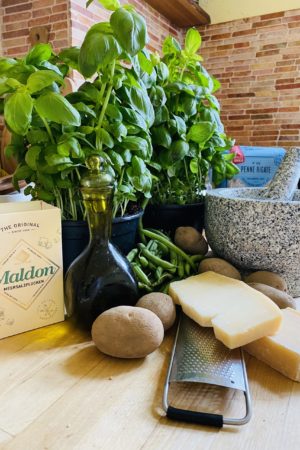
This time we go to the northern part of Italy to check for the original Pesto Genovese. Mario will give some informations about the origins of his recipe, but i can tell already that this is miles away from what most people, including me especially at younger age, have in mind when they talk about Pesto. It is not that cheap cream from the supermarket that you blob on your overcooked spaghetti as a student.
The term Pesto comes from the italian word „pestare“, which means mashing / grinding.
So in order to prepare it properly i bought a massive granite mortar & pestle, which has a 20cm inner diameter and weighs more than my cats together. And that investment was worth every penny.
It might be not easy to find the Pecorino Sardo, but as with the Ricotta Salata for the Pasta Alla Norma, it´s worth to walk the extra mile to get it.
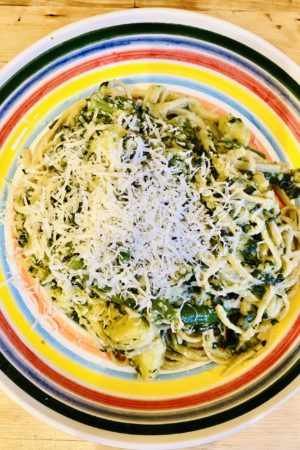
Pesto Genovese con Patate & Fagiolini
Pesto Jahknowese by Mario
Before i start with the recipe, an introduction is more than needed to clear something about the “original press” Pesto Genovese. Whenever you go to the supermarket and decide to buy pesto, be sure that it has “Pesto Genovese” stated on the label. If you want the real deal, do not buy the “pesto alla genovese” or other pesto named differently from “Pesto Genovese”, a name protected by the D.O.P. to preserve it’s origin.
For the original recipe you need 7 ingredients:
• Genovese Basil (this Is a typical DOP basil that grows up in Liguria and is picked when the plant is still small, with tender leaves that obviously are rich in taste)
• E.V. Olive Oil, best if it is from Liguria or at least a gentle one.
• Parmigiano Reggiano (or a good Grana Padano should be ok too)
• Sheep milk Pecorino cheese “Fiore Sardo” (a typical cheese from Sardinia that is widely used in Liguria as many other Sardinian products, because until the start of the XXth century there was a big naval commerce between Sardinia and Liguria so you can find many similar products and recipes in the two regions)
• Pine Nuts. (traditionally in the inner regions of Liguria the pesto is also made with peeled nuts, but that’s a variation to the classic one, nuts are more typical for the “agliata sauce” that’s like a pesto made with garlic and nuts.
• Garlic. (Many people dont use garlic in the pesto for the smell, but traditionally Genovese Pesto is a seasonal recipe made from spring until the beginning of the summer, so along with the young basil, which has the best taste around that time, you will also get the best freshly picked garlic cloves that have a fresh taste and dont smell that strong.
First of all, for the real pesto genovese you will need a mortar but just because we are in 2020, there is this Corona Virus problem outside and it’s better to stay home you can also use a blender (is the same if u use the immersion one or the classic one, just follow the instructions and your pesto will sort out in a shiny green color) Before to start be sure to have an ice cube into the freezer because the blender will warm up while mixing and you will need to keep the pesto cold, and toast your pine nuts so you will have them cold when u need them)
Ingredients:
• Basil (genovese one is hard to find so just try to avoid the bigger leaves and to use just leaves and not the sprigs) 100 gr
• Evo olive oil 150 cl
• Pecorino Fiore Sardo 50 gr
• Parmigiano Reggiano 140 gr
• Garlic 2 or 3 peeled cloves (be sure to cut in half the clove and to keep away the heart of the garlic)
• Pine nuts 30/40 gr
• Sea salt put just a pinch in the start and then you taste and fix while blending
• some potatoes
• some green beans, cut in half
Process with mixer
First step is to prepare a fatty base to put the basil into, without letting it oxidate and turn black.
So put all the ingredients (beside the basil) into the blender and mix until it gets creamy and oily. Put that mix into the fridge for about 1 hour and let it cool down (if you can, put also the blender cup into the fridge, maybe you will not need the ice cube then)
In the meantime wash your basil, pick all the leaves and dry them as the best you can, without pressing them too much and losing the essential oil.
Take the cold mixture from the fridge and add basil, 1/4 by a time, and mix at the highest speed for few seconds. If the blender is not strong enough it will get warm so you need to add that ice cube to cool down the mix. In the end taste it and if needed, add some salt, give it another fast turn in the blender and its done.
Process with mortar & pestle
First step is to put the mortar in the deep freezer about 1 hour before you start „pestling“. Once it is cold enough start to roast the pine nuts and prepare the basil, as above. Then add the ingredients step by step to the mortar, mash and grind them until they get the desired texture. Best way is to add a bit of every ingredient at a time and then step by step add more. That way its easier to balance the taste.
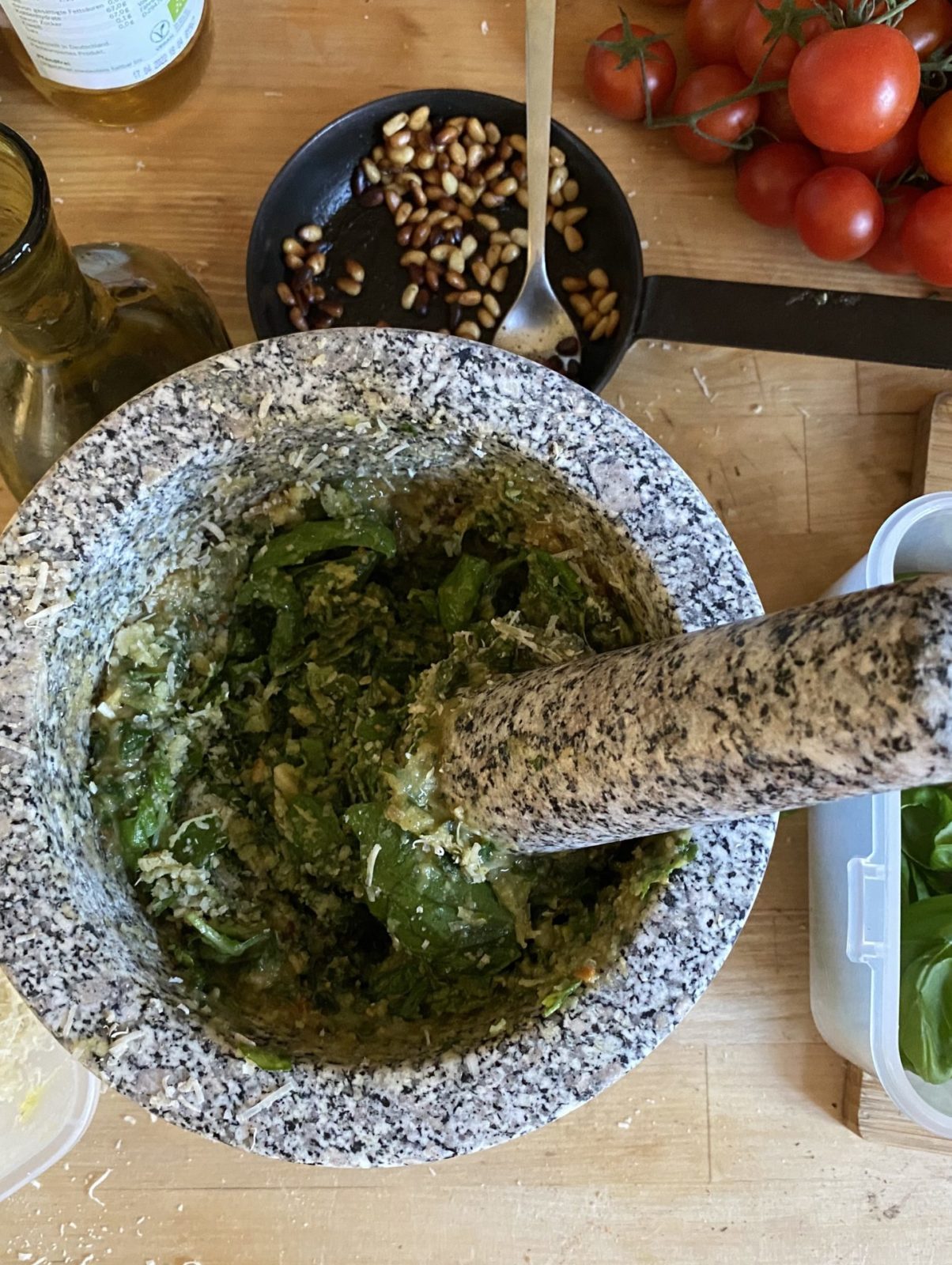
At this point you should be ready to bring pot of water to boil.Then add your favorite shape of pasta, some 1,5 cm diced potatoes and some half cutted green beans, when pasta is ready also the other ingredients should be ready, so you can drain your pasta and into a cold bowl you can season it with your own sauce. (I love to put few drops of lemon juice at the very end before to serve)
This pesto is a basic sauce that you can use in a million different ways, like seasoning a vegetables sauté, a soup or a cereal salad. Or you can use it to fill some fresh egg pasta, or put some on the top of a risotto, use it for a layer of a baked lasagna, for example as pesto béchamel and ricotta.
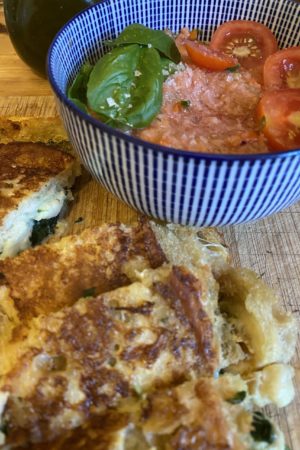
Mozzarella in Carrozza con Pesto & Gazpacho
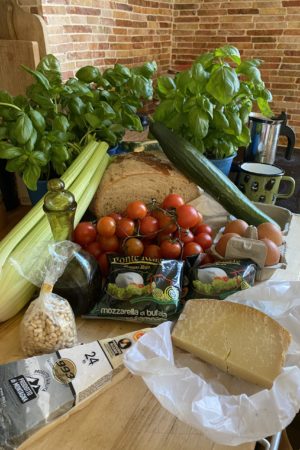
Pesto & Mozzarella in Carrozza with rapid-fire gazpacho.
Take a mozzarella and cut it in slices (the industrial one will be ok for this because it’s just a yummy snack to do at home). Put it on a plate and dry a bit by pressing the slices with absorbing paper.
Then put a pan with some frying oil on the fire. (you do not need to deep fry you just need around a cm of oil in the pan)
Take two slices of bread, best if they are from the day before, cut off the crust and put some pesto on it. Then add the mozzarella and close the two slices to do a sandwich and press it as much as you can. Put one egg and a little bit of milk into a bowl, mix it add a pinch of salt. Soak your sandwich in this mix for a minute each side and then fry it in the pre heated pan until it is brown on each side.
Then dry it on absorbing paper, cut in sticks and serve as garniture for a fast gazpacho.
The Gazpacho is made of some cherry tomatoes, the juice of half lemon, a little piece of celery, cucumber and red onion, a couple of the bigger basil leaves left from the pesto and some spicy Calabrian red pepper. All mixed in the blender at the highest speed for about two minutes (add some evo olive oil and some salt just at the very end or the mix will lose the red color of tomatoes)
Melanzane 3 The Hard Way
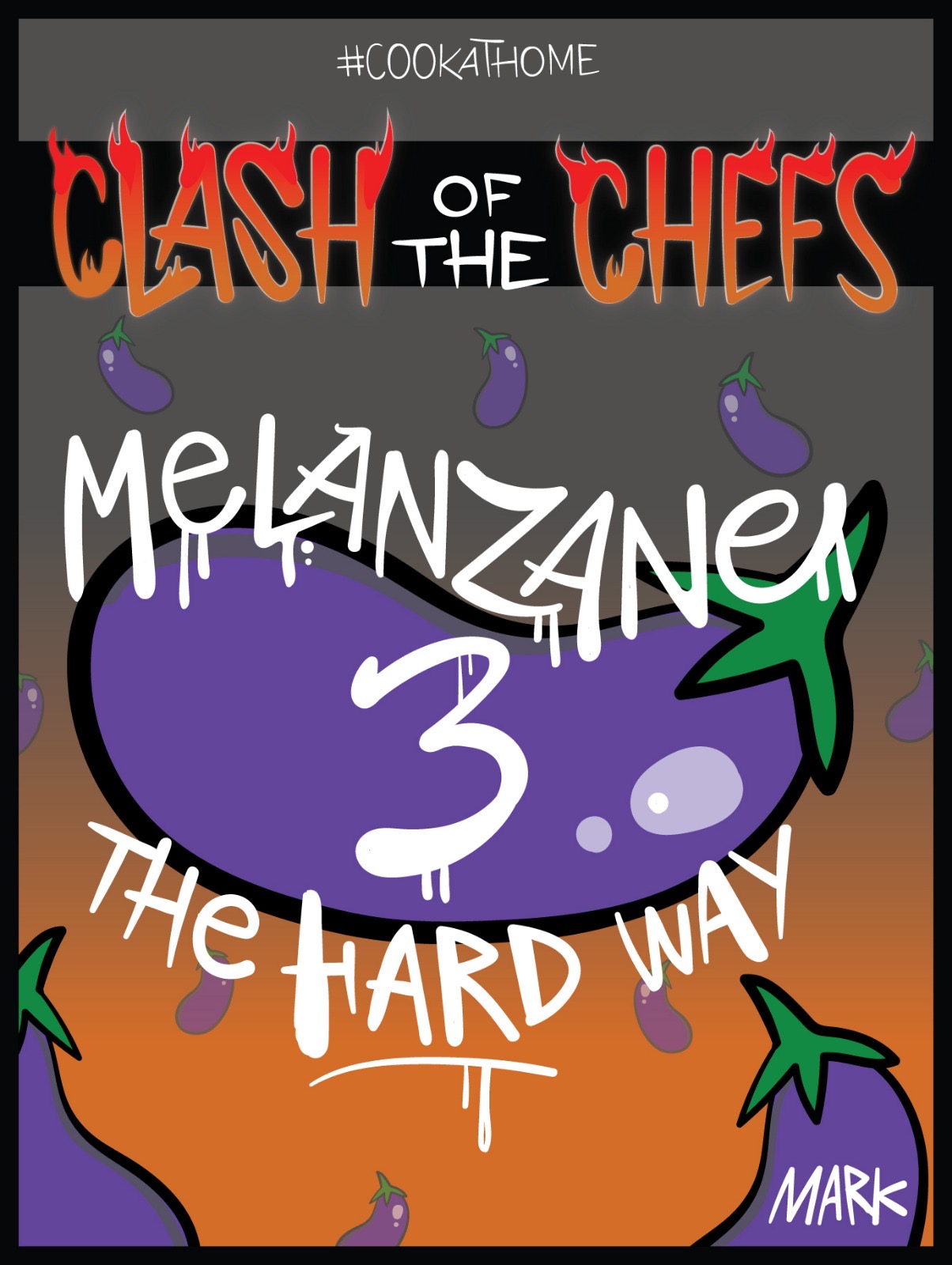
The eggplant (in Italian Melanzane) is one of my favourite plants to eat (nothing comes close to tomatoes though).
Yet i always have difficulties to prepare it properly by myself at home. To get a little overview of the variety this vegetable has to offer, Mario and me decided to go for a Melanzane 3 The Hard Way.
You dont have to cook those recipes all at once, but if you do, you will have a nice starter, primo and secondo.
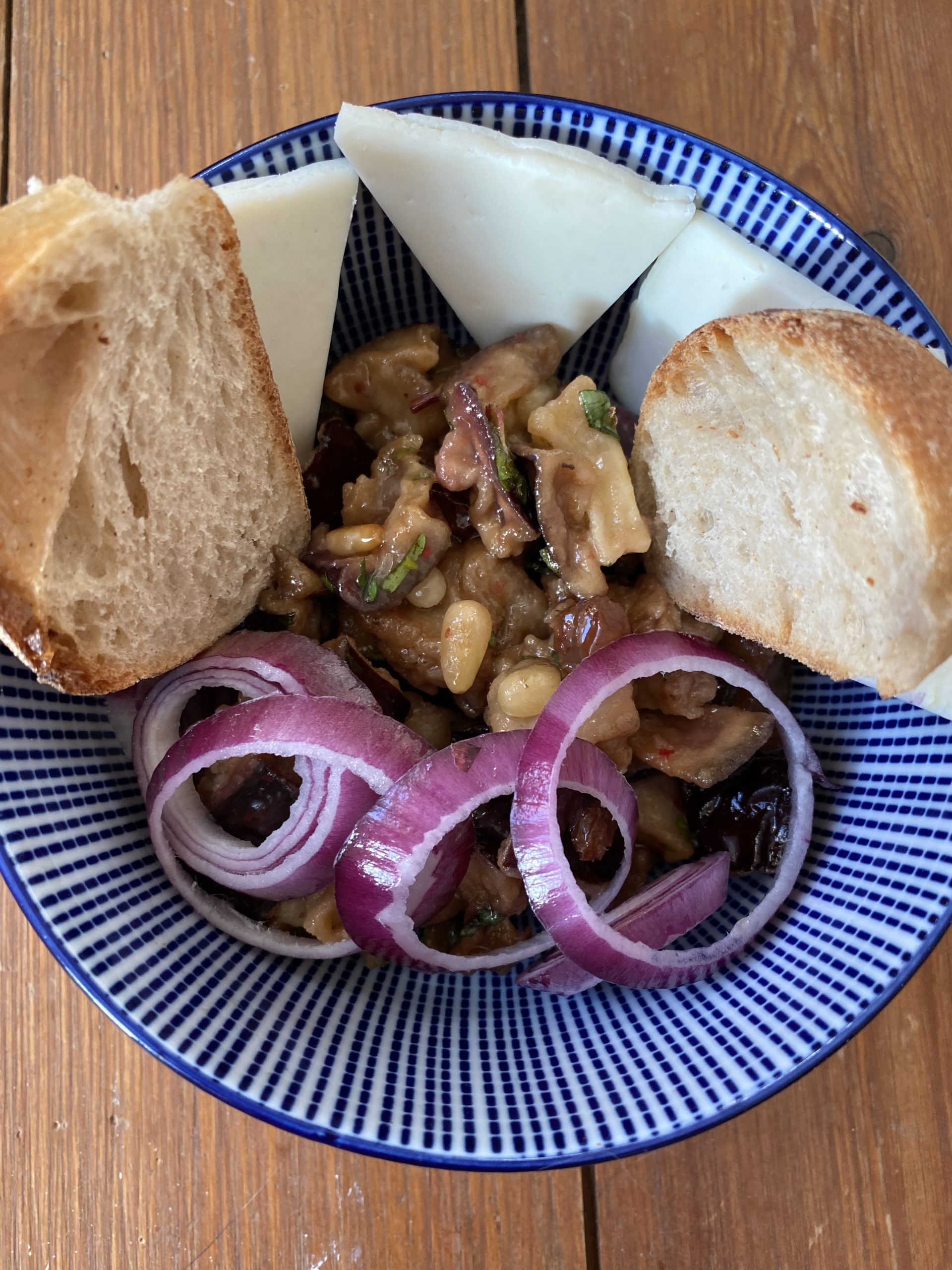
Melanzane Agrodolci
Every time i go to Roma i have at least to try to go to the Osteria Rouge in San Lorenzo. This place holds so much memories of evenings with family and friends, it is much more to me than just a place to eat.
Beside the regular dishes there is one antipasti that can never be left out when i place my order at Rouge. The Melanzane Agrodolce to me is their trademark dish, i tried to do it by myself numerous times, but always failed to get a proper result.
Recipe by Mario
Sicilian style sweet & sour Eggplants
Ingredients:
3 small eggplants, around 500/600 gr (for this recipe it’s better to avoid the purple and round ones, go for the classic and try to choose some small ones)
100 gr. white flour
40 cl. white wine vinegar
60 cl. apple vinegar
50 cl water
60 gr. brown sugar
2 leaves of lauriel
some black pepper grains
some cloves
a few leaves of basil, mint and parsley
1 clove of garlic
fresh red pepper
pine nuts
raisins (did you know that the most famous and expensive ones comes form new zealand?)
peanut oil, just enough to deep fry the eggplants (peanut oil is the best because it has the highest burning point)
Put your raisins in some water for about 1 hr, then rinse and dry on some absorbing paper.
Toast your pine nuts in a pan (never use pine nuts without toasting them before or they will lose a lot of flavour and dont toast them too long)
Put the two vinegars, water, sugar, laurel, cloves and pepper all together into a small pot and cook it until it is reduced to 1/3 of the quantity. Then filter it and let it cool down, this one will be the sweet and sour syrup for the eggplants seasoning.
Cut the eggplants in 2 cm dices and put them into the flour, take off the excess flour with a sieve and then fry them in a pot with enough peanut oil to cover the eggplants (oil must be around 180°C). Do not fry all the eggplants together, do it little by little to avoid the oil sponge effect. If you fry too much eggplants at once the temperature will go down fast and they will not deep fry as fast as they should. (This is a rule to follow whatever you are frying). When the eggplants are coloured enough take them out and put them on some absorbing paper.
Once the syrup is at room temperature, put your fried eggplants into a bowl, add some salt, some red pepper, the chopped fresh herbs , pine nuts, raisins and some sliced garlic and turn gently (if possible with a wooden or silicone spoon). Then put the syrup over the eggplants and let rest for at least 2 or 3 hours before eating them.
Depending by your taste you can use some more vinegar or less sugar, depending on your prefered sweetness or the acidity of the syrup.
This syrup is the same as used for “Caponata” or pepperoni in agrodolce.
My Result
Me and my friends, who were lucky enough to get a portion it, were really satisfied by the result. I think next time i will use a bit less sugar, but maybe it was more sweet as i did reduce the syrup to 1/5 or less from its original volume, and not 1/3 as Mario suggested.
Also i was surprised how little smelly the frying process was, i guess that was a nice side effect of using peanut oil instead of any other cheaper oil.
While i cant wait to be at Rouge again, this recipe is a nice solution to beat time until it will be possible.

Pasta Alla Norma
When i’m in Sicily i always have to check for the best Pasta Alla Norma (similar to my Cacio Pepe researches when i´m in Rome).
This dish is so full of flavour, the mix of fried eggplants, tomato sauce and the unique taste of Ricotta Salata, fingerlicking good!
It might not be easy to find the Ricotta Salata in your regular supermarket, but its definetely worth to walk an extra mile for this.
Recipe by Mario
This one is an easy recipe, so the most important thing to get a perfect result is to get the best ingredients!
400 gr of pasta (this recipe is very versatile, and even if the original recipe is with spaghetti, the one I prefer is Mezze Maniche Rigate)
500 gr peeled San Marzano tomatoes (or 1 kg of fresh ones, if you find them ripe enough with full flavour)
2 garlic cloves
3 medium size eggplants (this time the most common one which is round and violet)
Basil (about 10/12 leaves at least)
some EVO olive oil for the tomato sauce
peanut oil, just enough for frying the eggplants (always follow the rule “little by little” when you fry eggplants to avoid the sponge effect)
Ricotta Salata
First step is to prepare a good tomato sauce in a classic southern Italian style, so put your pot on the stove with some evo oil and the garlic, let it get warm, add the tomatoes and cook with half of your basil, a couple pinches of salt and an half teaspoon of sugar.
Let your tomatoes cook for about 40 minutes at least. And if needed add a half glass of water, then let the sauce cool down before you mix it with the blender. Otherwise your sauce will lose much of the red color and the tomatoes will turn orange (it will taste good sameway, but also your eyes want their share).
While your sauce is cooling down like Gregory you can cut your eggplants in 2 cm dices, put them into a colander with some salt. Let the eggplants lose some of the bitterness contained in their water. After about 30 minutes you can rinse the eggplants and follow to dry them as best as you can. Then deep-fry them in a hot peanut oil pot around 180°C until they are brown, dry them on some absorbing paper. (If you are asking why to use salt this time, it’s because you will not have a sweet and sour syrup for seasoning the eggplants, so you will need to balance the flavours during the process. Same process is needed when preparing Parmigiana for example)
At this point your sauce should be cold enough so you can take out the garlic cloves and mix it with your blender.
When your sauce is smooth put it on the stove again, if needed add another half glass of water and let the sauce cook for 20/30 minutes again, taste and check if you need an extra pinch of salt.
While your sauce is bubbling again you can boil the water to cook the pasta.
Once the water is boiling put some salt in the water and add your pasta.
A couple of minutes before that your pasta is ready put some salt on your eggplants and then put 3/4 of the fried eggplants and the remaining cutted basil leaves in your sauce. At this point do another final salt check.
Drain your pasta and mix it with your sauce. If you like it you can add also some fresh red pepper, it’s not very traditional but it’s always on the family tables in South Italy.
Now all you have to do is to put the Pasta Alla Norma on a plate, add the remaining fried eggplants on top and cover the dish with a generous amount of ricotta salata.
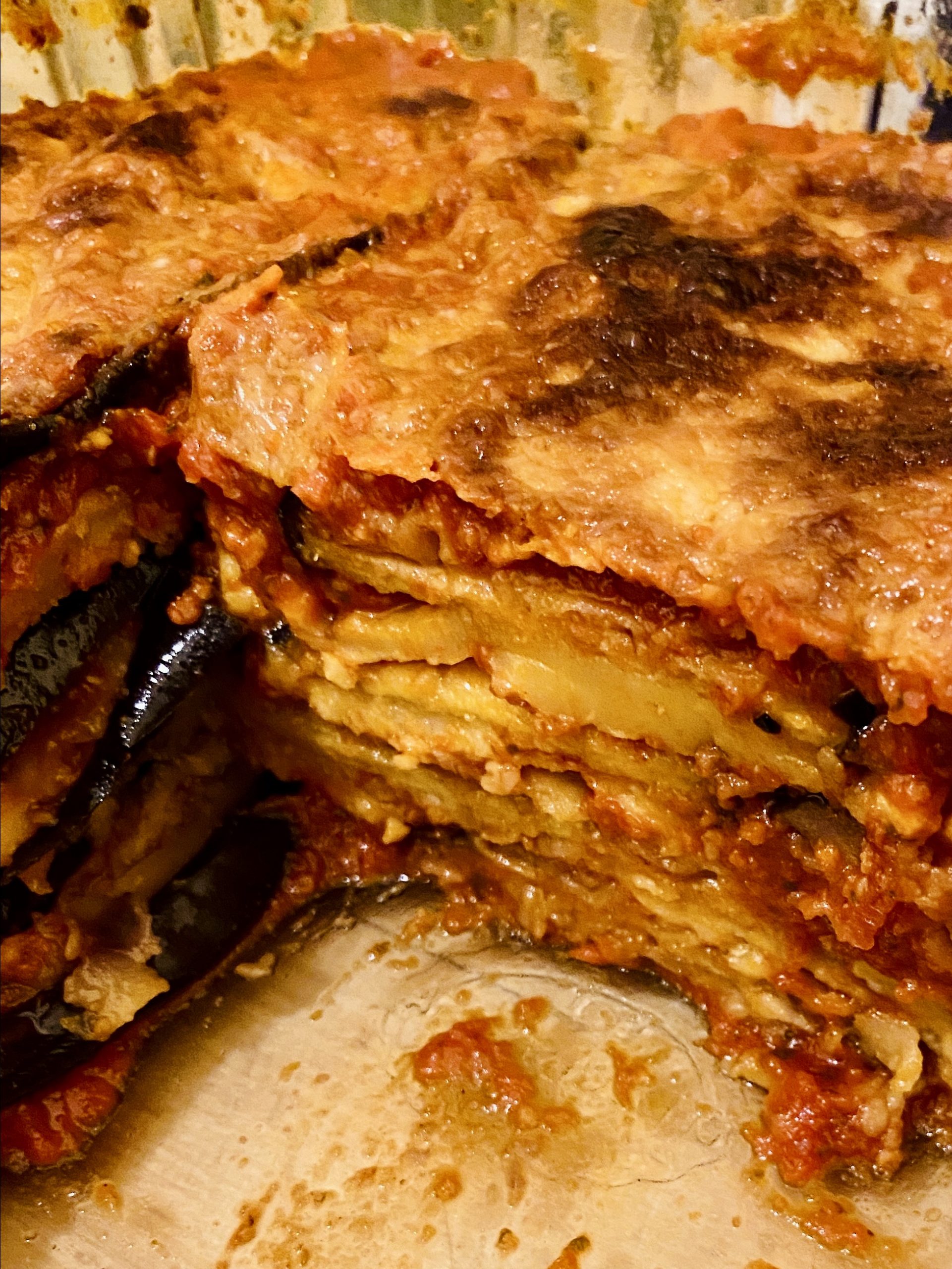
Melanzane Alla Parmigiana
As most of my (non-italian) friends i was thinking for years that the word Parmigiana is coming from the use of Parmigiano cheese. But the name of this typical south italian dish basically means that it is prepared in layers that will be baked in the oven.
On my research i came across this therory that it is the Italianization of the Sicilian dialectal word “parmiciana”, which refers to the slats of wood which compose the central part of a shutter and overlap in the same manner as the slices of eggplant in the dish.
It is not limited to eggplants alone, even though that might be the most common one.
Zucchini alla Parmigiana is another popular example for this typical layer bake.
Normally you dont eat it burning hot from the oven, but let it cool down a bit and serve it as second course. Or for Antipasti as a cold dish.
My experience from cooking it 3 weeks in a row is, that with one casserole your belly is full for at least 3 days (if you dont intend to share it ;-). I would say it takes a few times until you find out how much tomato sauce, cheese, eggplants you need. It also depends on the size of your casserole.
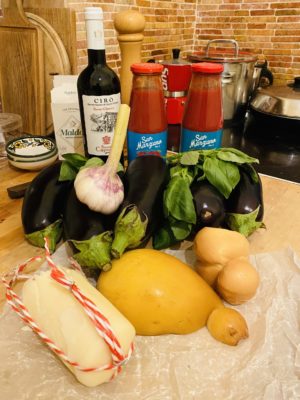
– 3 Regular Sized Eggplant
– Flour
– Provola (non smoked) in slices
– Scamorza (smoked) in slices
– Provola (smoked) in slices
– Parmigiano Reggiano
– Basil
Prepare the tomato sauce the same way as for the Pasta Alla Norma, but you can use some more basil this time.
Cut the eggplants in slices, about as thick as your little finger, salt them and put them to rest for about 1 hour to get the water and bitterness out. Then dry them as good as possible.
Cover the eggplant slices first with flour and then fry them with peanut oil, remember to fry them in small amounts to avoid the sponge effect.
Now we can start to fill the casserole, starting with some tomato sauce at the bottom, then a layer of fried eggplants and another layer of tomato sauce. Choose one kind of the sliced cheeses and put them on top and finish with some Parmigiano. Start with eggplant again and continue until you have 4 layers of eggplant and 3 layers of cheese. Put some Parmigiano in each layer as well. You can also use only one type of cheese for all the layers, depending on your preference and also availability in your area. The last layer should be eggplants that will get covered with tomato sauce and a generous amount of Parmigiano.
Put the casserole in the oven for about 30 minutes at 200 Degrees Celcius.
Then let it rest for a while, if you can resist the temptation, let it rest until the next day before you eat it. You can just warm it up in pieces. If you let it rest for a while the texture will become more solid and you can cut out solid pieces.

As with most recipes there is not only one variation. Another friend of mine of mine, whose family is originally from Napoli, is doing it slightly different.
For this one you mix eggs with some parsley, put the eggplant slices first into the flour, then in the egg/parsley mix and fry them with peanut oil.
And on the top layer use pieces of Mozarella Di Bufala instead of Parmigiano.
I did both variations and really enjoyed both of them. The one with Mozarella and eggs was a bit more juicy in texture. It’s a perfect soul food for cold winter lockdown evenings at home.
I hope you enjoy!
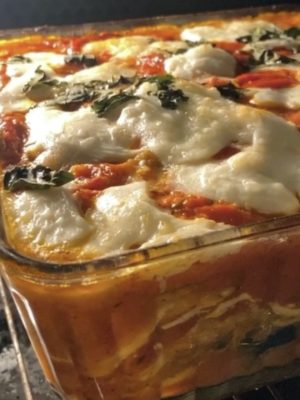
Carbonara Vegetariana
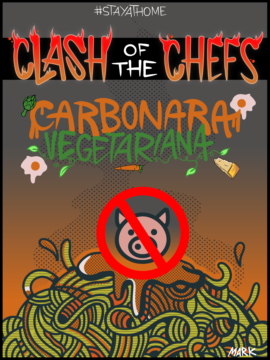
A dish that i used to eat quite often until i did stop eating meat about 15 years ago. But even then i never cooked it by myself. Lets see how Manu and Mario will guide me through my first own vegetarian Carbonara.
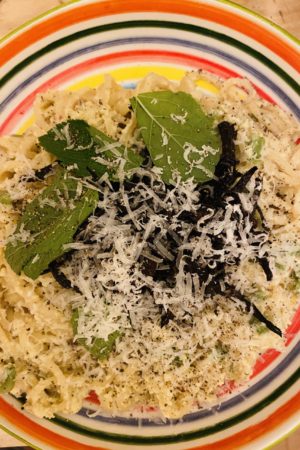
Manus's Recipe
Manu’s Carcionara
Recipe for 4 people
Spaghettone 400 g
Eggs 4 n
Artichokes 4 n
Pecorino cheese 70 g
Parmigiano cheese 40 g
Black pepper qb
Pink pepper qb
Fresh Mint qb
Salt qb
Olive oil qb
Garlic 1 n
Bring water boil in a big pot.
While it starts to boil peel off the outer layers of the artichoke’s stem and cut the inner part in little square pieces.
Put those pieces (with a sieve or similar) in the hot water for about 20 seconds and then quickly move them in another pot/cup with water and ice cubes.
Cut off the prickly outer leaves of the artichokes and extract the heart, cut it in thin julienne and fry them in plenty of oil until they get crunchy, 3 minutes more or less.
In the same water where you did cook the stems before you can cook the Spaghettone for 6 minutes.
At the same time cook the stems with garlic and oil in another pot, take off the garlic when it becomes blonde.
Add those stem pieces to the other pot and cook them together with the pasta for 5 minutes or until the pasta is “al dente”)
In the meantime mix the eggs with the grated pecorino, parmigiano and pepper (black and pink)
Take the pot off the fire,drain the pasta and put it back into the pot. Start to mix in the eggs, stir everything with low fire. Be careful that the eggs with pasta do not go above 65 degree so it stays creamy doesnt stock.
When it has the desired texture put it on a plate and finalize with the crunchy artichokes on the top and add some mint leaves.
My Result
I did start with Manu’s recipe as it took overnight to prepare the carrots used for Mario’s recipe.
During the cooking process i quickly realised how much of an amateur i am in the kitchen and i immediately got even more respect for people like Manu and Mario working in the kitchen preparing hundreds of meals everyday.
Those 20 minutes of cooking the dish felt like playing a round in a soundclash to me. Within a limited time frame i had to juggle with at least 3 components and make sure all of them are doing fine.
The result was pretty good still, but i would need a 2nd try someday. The 2 mistakes i made was 1. to fry the carciofo julienne a bit to long so they were on the edge of getting burned and 2. i did underestimate the reaction of the egg/cheese mix to high temperatures, so the sauce was not as creamy as it should be.
But otherwise i really enjoyed that meal, the cooked carciofo stems had a nice texture and to add mint did really round up the dish.
Well done, Manu!
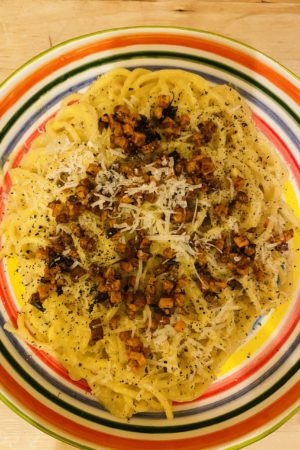
Mario's Recipe
Mario’s Carrotbanara
I can’t call this recipe just “Vegetarian Carbonara” because there is no carbonara without the right kind of pecorino cheese and most important, the right “guanciale”, that comes from Lazio and Abruzzo regions in Italy, thanks to the perfect balance of spices, herbs and knowloedge of the local producers. If you are not vegetarian and you need some hint for a good guanciale I think that Manu should have the right links after he lived so long in Rome and is a “Carbonara Maestro” (He is famous in our city for the Tuna Carbonara).
For my recipe I decided to stay close to the traditional way of prep for the pasta and for the sauce but with some professional tips to get a good result, also at the first attempt.
What to use to replace guanciale? Well, I go for carrots that I marinate in salt and sugar and some spices, then I put them in olive oil and roast them like bacon to replace guanciale. I like carrots because they are really meaty after being marinated. They get this texture, this sweet and salty taste mixed with the herbs and spices ,that smoky taste that can seem like crunchy and fatty guanciale.
-For the fake guanciale:
1 large carrot
100 gr of brown sugar
120 gr of smoked salt (with the regular one you will lose some of the meaty taste given by the smoked one)
2 pieces of garlic (cut in thin slices)
Some fresh herbs: thyme, majorane, rosemary, lauriel
Some spices: 3 or 4 grains of juniper, a tablespoon of black pepper a pinch of cayenne pepper
Extra virgin olive oil (just enough to cover the finished carrots)
Wash and peel your carrot and cut it in your favorite shape. I like it diced around 0,5 cm. Try to avoid the heart of the carrots because it’s harder to marinate, you can eat it raw while you prepare all your stuff.
Then mix in a blender the sugar, salt spices and herbs (it’s way better if you roast your spices before to do this step to get the maximum flavour from them).
Put half of your mix into a box, add the carrots and the garlic and cover with the other part of the mix. Leave it like that about 1 or 2 hours (it depends on the freshness of the carrots)
After that time take off the carrots from the marinate, rinse and dry them, then put into the extra virgin olive oil (best to use a strong one from southern Italy)
Leave your carrots in olive oil for a night (they can stay in olive oil for a long time if well preserved into the fridge) and then when you want to use them take some and roast them in a hot pan with theirs own olive oil as you would do for guanciale or pancetta.
-for the eggs and cheese sauce
Usually I go for one medium egg yolk each 50 grams of pasta, you can use a bit more if you use pasta like rigatoni or paccheri or similar shapes.
So let’s prepare sauce for 100 gr of Spaghetti (do not use industrial pasta, when pasta is too smooth that’s not a good one)
100 gr Spaghetti
2 egg yolks. (About 50 grams)
30 grams of “Pecorino Romano” sheep milk cheese (not too fresh or it will melt like mozzarella)
30 grams of “Parmigiano Reggiano” at least aged 18 months (btw, parmesan is not parmigiano…)
A lot of black pepper (better if in grain and then toasted and chopped when you need it)
10 grams of good butter (if you take off meat you will need some fat to get a greasy dish of carrotsbonara)
Put a pot of water to boil, meanwhile you mix in a bowl egg yolks with pecorino, parmigiano, a pinch of salt and black pepper and start to whip just enough to obtain a hard creamy mix. Start to warm this mix on the boiling water whipping it constantly to avoid the overcooking of egg yolk (over 82°C it will start to overcook), let’s keep around 50°C, so when you will add the hot pasta there will not be a thermal shock, that would cook the yolks too fast.
When water is boiling put some salt in it and put your spaghetti to cook for about one minute less than the recommended time written on the packaging.
While pasta is cooking take a about an half cup of cooking water (the foamy one on the top is the best because is rich of starch that will tie the sauce) and put that in the yolks and cheese blend to keep it warm and to let it become smoothie and fluid.
When pasta is ready drain it (but remember to keep another half cup of cooking water in case you will need to put some in the pasta when seasoning) and wait few seconds before to put in the sauce, then take a cold pan put your pasta, the butter and start seasoning, after that put the eggs sauce inside and continue to move it constantly, put the pan on the fire for few seconds and then take it off and repeat the for a couple of times to keep it warm but not enough to overcook the yolks. In less then one minute your pasta is ready to be putted into a dish and topped with your roasted meaty carrots.
Then add some more black pepper on top and eat it warm.
My Result
I have to admit that when i read Mario’s recipe i was a bit nervous about getting everything right, especially the sauce.
I never did marinade anything before in my life and getting all the ingredients, especially in these restricted Corona shutdown times was a small challenge by itself. Or would you know where you can get smoked salt within walking distance from your home?
In the end i have to say it was pretty easy to prepare and the instructions for the sauce look more complicated than they are in reality.
Thanks to my learning experience from the day before i was super cautious with the temperatures this time and was rewarded with a nice creamy sauce.
The fake carrot guanciale was amazing, taste and texture were really meaty, well as much as i remember that from my past.
I’m really happy i had the idea with this challenge and Mario and Manu take their time to contribute.
Only problem is that i feel like i did gain about 5kg since yesterday 😉
Thank you, Mario!



